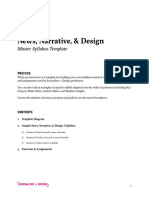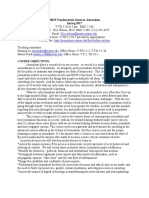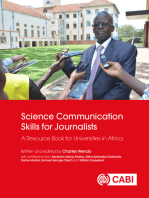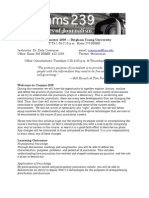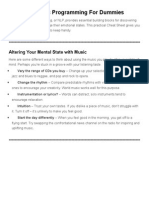Introduction To Journalism
Uploaded by
nanusesignaciaIntroduction To Journalism
Uploaded by
nanusesignaciaUniversity of Namibia
Department of Social Sciences
H3521CJ: Introduction to Journalism
Course Outline (2024)
NQF level: 8
Contact hours: Mon. 14:30 | Tue. 13:30 | Thu. 11:30 | Fri. 13:30
Venue: X149
Notional Hours 160
NQF credits: 16
Prerequisites: None
Options: Compulsory
Semester offered: 1st
Lecturer: Dr. Stanley Tsarwe
Office: AA029
E-mail: stsarwe@unam.na
Consultation hours: Mon – Fri 8.30-10.30. Or just drop in.
Class attendance:
Class attendance is compulsory. If you are unable to meet a deadline, you are expected to inform me
in advance (at least a day before deadline) with evidence supporting your inability to meet the
deadline. Otherwise you will be penalized for late submission. Tests and the final examinations are
based on lectures and discussions in class and extra readings. It is also good manners to inform me if
you will not make it to class. It is a university policy that if you do not achieve 80% attendance you
will not be allowed to write the final examination.
Course description:
The course introduces students to the historical development of journalism from the sentinels to
satellites, background and issues in journalism, researching and recording information, newspapers
and magazines, print layout and production, online journalism, social media, multimedia journalism,
information graphics, data-driven journalism, health and safety, central and local government,
careers and training. The focus will be on developing critical thinking in the use of the English
language in news story writing.
Methods of facilitation of learning:
Lectures, project and problem-based learning, group work, class discussions and presentations.
Resource: Course Outline; PowerPoint presentation, Reading lists, UNAM Portal/Moodle Learning
Management System
Assessment Strategies:
Continuous Assessment 60% (minimum of 1 test and 2 assignments), Examination 40% (1x3 hour
paper).
Quality assurance arrangements:
Internal and external moderation of assignments
Peer review of course outlines and teaching.
Student evaluation of lecturers and the course at the end of every semester
Regular review of the programme and course content in consultation with stakeholders
Timely grading and feedback on assignments
Learning outcomes (LO):
Upon completion of the course, students should be able to:
1. Trace the history of journalism
2. Compare and contrast traditional and online journalism
3. Write for the student newspaper by demonstrating an excellent grasp of the English
language
4. Apply infographics and data journalism in news stories
5. Recall journalism concepts
6. Review issues in journalism practice
7. Outline impact of social media on journalism practice
Course Content
Week 1: Introduction
Course Outline
Getting to know each other
Setting ground rules
Introduction to the module
Week 2: Outcome 1: Trace the History of Journalism
Evolution of the printing press
Journalism as Story telling
What is news and news values
Journalism norms and values
Week 3: Outcome 2: Compare and contrast traditional and online journalism
Traditional journalism
Online journalism
Differences and similarities
In class test
Week 4: Outcome 2: Compare and contrast traditional and online journalism
Social media impact on journalism
Journalism ethics
Online Surveillance and Safety
New ways of data gathering
Week 5: Outcome 3: Write for the student newspaper by demonstrating an excellent grasp
of the English language
News ideas for the magazine
Writing news articles for the student newspaper
Language and structure
English for mass communication
Week 6: Outcome 3: Write for the student newspaper by demonstrating an excellent grasp
of the English language
Writing stories for the student newspaper
Selecting qualifying stories for the student newspaper
Editing stories for the online newspaper
Assignment 1
Week 7. Outcome 4. Apply infographics and data journalism in news stories
Data journalism
Visualization: using excel to create bars, chats, tables
Creative pivot tables in excel
Week 8. Outcome 4. Apply infographics and data journalism in news stories
Data ethics
Data safety
Assignment 2
Week 9: Outcome 5. Recall journalism concepts
Fact checking / Adversarial Journalism / Audience / Bad News / Bias / Context Analysis /
Defamation / Dumbing Down / Editor / Embargo / Embedded Journalist / Ethics / Focus
Groups / Free Newspaper / Gatekeeper / Hard News /Ideology / Impartiality /
Infotainment.
Week 10: Outcome 5. Recall journalism concepts
Investigative Journalism / Mass Communication / Media Effects / Media Mogul /
Multimedia / Myth / Narrative / Digital Media / News Management / Off the Record /
Online Journalism / Photojournalism / Propaganda / Self-regulation / Sensationalism /
Tabloid.
Week 11: Career Prospects
Career prospects for journalism students
Journalism, the newsroom and gender dynamics
Newsroom cultures, practices
Week 12:
Revision
Learning Resources
Prescribed
Rudin, R., & Ibboton, T. (2013). An introduction to journalism: Essential techniques and background knowledge.
New York, NY: Focal Press.
Recommended
Nelmes, J. (2012). Convergent journalism: An introduction: Writing and producing across media. Burlington M.A.:
Focal Press.
You might also like
- J562 Reporting II Fall 2020 Syllabus v1No ratings yetJ562 Reporting II Fall 2020 Syllabus v127 pages
- J462 Reporting II Spring 2021 Syllabus v1No ratings yetJ462 Reporting II Spring 2021 Syllabus v131 pages
- Damian Radcliffe J462 Reporting II Spring 2020No ratings yetDamian Radcliffe J462 Reporting II Spring 202024 pages
- News, Narrative, & Design: Master Syllabus Template100% (1)News, Narrative, & Design: Master Syllabus Template16 pages
- J301F Fundamental Issues in Journalism Spring 2017: Shuninglu@utexas - Edu Martin - Riedl@utexas - EduNo ratings yetJ301F Fundamental Issues in Journalism Spring 2017: Shuninglu@utexas - Edu Martin - Riedl@utexas - Edu4 pages
- Winter 2023 English For Journalism SyllabusNo ratings yetWinter 2023 English For Journalism Syllabus5 pages
- Fall 2022 English For Journalism SyllabusNo ratings yetFall 2022 English For Journalism Syllabus5 pages
- 662 - Ok JOUR 30023 News Reporting and Writing by Plathottam (COMMON) For BAJ 1-1D, 1-1N & 1-2NNo ratings yet662 - Ok JOUR 30023 News Reporting and Writing by Plathottam (COMMON) For BAJ 1-1D, 1-1N & 1-2N235 pages
- Science Communication Skills for Journalists: A Resource Book for Universities in AfricaFrom EverandScience Communication Skills for Journalists: A Resource Book for Universities in AfricaNo ratings yet
- Sophia BMM TYBMM SEM V Journalism SyllabusNo ratings yetSophia BMM TYBMM SEM V Journalism Syllabus28 pages
- MSJM03 Comparative Journalism (Swansea Uni) 2023-24No ratings yetMSJM03 Comparative Journalism (Swansea Uni) 2023-2433 pages
- WCS 201 Introduction To Journalism Spring 2022 Instructor Details Class DetailsNo ratings yetWCS 201 Introduction To Journalism Spring 2022 Instructor Details Class Details7 pages
- Journalism International Program SyllabusNo ratings yetJournalism International Program Syllabus4 pages
- SJI Perdana Indonesia Jounalist Association (PWI) Institute Bandung 9 Feb 2024No ratings yetSJI Perdana Indonesia Jounalist Association (PWI) Institute Bandung 9 Feb 202414 pages
- 2025 Print News Reporting Course Outline. UnimacNo ratings yet2025 Print News Reporting Course Outline. Unimac5 pages
- Course Syllabus: EN 217.OL - Journalism I (Online)No ratings yetCourse Syllabus: EN 217.OL - Journalism I (Online)9 pages
- Fall 2023 English For Journalism SyllabusNo ratings yetFall 2023 English For Journalism Syllabus5 pages
- English for Journalism Syllabus Summer 2022No ratings yetEnglish for Journalism Syllabus Summer 20225 pages
- Fall Semester 2009 - Brigham Young UniversityNo ratings yetFall Semester 2009 - Brigham Young University8 pages
- TY Journalism SEM 5 - SEM 6 SYLLABUS 2023-24 - Manasi JangamNo ratings yetTY Journalism SEM 5 - SEM 6 SYLLABUS 2023-24 - Manasi Jangam47 pages
- Assessment Tool Development, Teaching Model Construction, and Curriculum Design of High School Media LiteracyFrom EverandAssessment Tool Development, Teaching Model Construction, and Curriculum Design of High School Media LiteracyNo ratings yet
- Social Solutions for Climate Change: How to inspire action through social mediaFrom EverandSocial Solutions for Climate Change: How to inspire action through social mediaNo ratings yet
- Class Program With Teachers TVL EIM G11Patience 1st SemesterNo ratings yetClass Program With Teachers TVL EIM G11Patience 1st Semester2 pages
- Perception, Skill, and Cognitive PenetrabiltyNo ratings yetPerception, Skill, and Cognitive Penetrabilty21 pages
- 22. Session - Troop Organization and AdministrationNo ratings yet22. Session - Troop Organization and Administration12 pages
- Course Outline: No. Course Learning Outcome Programme Outcome Taxonomies and Soft-Skills Assessment MethodsNo ratings yetCourse Outline: No. Course Learning Outcome Programme Outcome Taxonomies and Soft-Skills Assessment Methods4 pages
- Skillsroad Career Quiz Results 1707828898060No ratings yetSkillsroad Career Quiz Results 17078288980606 pages
- List of Approved Post Graduate Education and Research Institutions Upto 30th September, 2004No ratings yetList of Approved Post Graduate Education and Research Institutions Upto 30th September, 200419 pages
- English For Law Students Charachteristics PDFNo ratings yetEnglish For Law Students Charachteristics PDF5 pages
- Gifted and Talented Events Participated in by Jps To End of AprilNo ratings yetGifted and Talented Events Participated in by Jps To End of April37 pages
- Best Coaching Centers For NEET in FaridabadNo ratings yetBest Coaching Centers For NEET in Faridabad5 pages
- July Intensive Courses Oral Exams 8 Tests: PET Speaking Test Part 3 201 202No ratings yetJuly Intensive Courses Oral Exams 8 Tests: PET Speaking Test Part 3 201 20225 pages
- A Troubled History of Job Creation: The Story Behind New Mexico's Chief Job Creators and Education ReformersNo ratings yetA Troubled History of Job Creation: The Story Behind New Mexico's Chief Job Creators and Education Reformers15 pages
- An "Insurrection" of Ontology? Judith Butler S Poetics of PoliticsNo ratings yetAn "Insurrection" of Ontology? Judith Butler S Poetics of Politics3 pages








